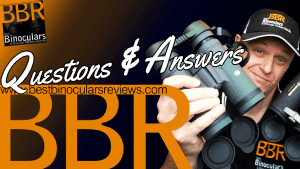

 |
||||||||||||||||
 |
||||||||||||||||
|
||||||||||||||||
Awards: Best Night Vision Device 2014
Before sitting down to write any review, I have to input all the main details of the instrument I am testing into my database so that it will show up correctly on the BBR website. One of the first sections to fill in is the name. This part is usually very straight forward and indeed the initial part for this one was easy, this is the Luna Optics LN-DM50-HRSD and whilst it does not roll off the tongue, there is no ambiguity. However I did have a problem describing exactly what it is: Is this simply a Digital Night Vision Monocular or should I call it a Day & Night Vision Recorder or a Digital Viewer? I guess in reality it is all of them (as well as a few more!) and that in a way sums up how this NV device spans a number of different areas and thus will appeal to a number of different users and potentially work well in a number of different situations.
Main Features & Specifications:
Analog
Before getting onto the main review, I just wanted to highlight that this is a Digital night vision device, which works quite differently to analog devices. Whilst they both take what little light is available at night and them amplify it to produce an image, they are quite different and each have their own respective advantages as well as disadvantages:
Most non digital work night vision equipment takes collects the light energy (photons) through the main lens and then with a photocathode they change it to electrical energy (electrons). This is then intensified and projected onto a phosphor screen, which then creates the green image that you look at.
This technology has been around for a long time and as such has come a long way and had been highly developed. The very best devices produce stunning quality images that work in the very darkest of conditions and the best are used by the military and law enforcement units.
However the best Gen II and Gen III devices (if you can get them) are very expensive and well beyond the range of most individuals. As well as this they cannot effectively be used during the day, indeed exposing them to bright light will probably damage them. The third disadvantage is because they are analogue, recording an image from them is very difficult and I personally have not seen any commercial analogue devices that can record (has anyone else?).
Digital
This Luna Optics LN-DM50-HRSD is a Digital night vision monocular and differs to the analogue ones in that the collected light is converted into an electric signal with the use of a CCD image sensor. This sensor is extremely sensitive and thus can increase the light, producing a visible image onto the LCD screen which you look at through the eyepiece.
The advantages of this include the ability to easily record the image produced onto a memory card, it can work in the day without fear of damaging it, you can make adjustments to the settings depending on the available light to produce a better quality image and it is far cheaper than the equivalent quality analogue device.
For more, please take a look at this page on How Digital Night Vision Works.
Design & Shape
The overall shape of the body is quite similar to that of most night vision monoculars and in a way quite similar to that of your camcorder in that they are designed to be held and operated for the most part single handed.
The vast majority of the external surface has been covered with a thin black rubberized coating and whilst this is probably too thin to provide much protection if you were to drop the device, it helps with, weatherproofing, grip and is less shiny than exposed metal, which if your aim is to stay hidden in the dark, is notable.
Rear
As you would expect, the eyepiece and eyecup are located on the rear. The eyecup's diameter is approximately 40mm and has a thin rubber eye flap/eyeshield that is excellent and does a great job of blocking out distracting light or movement from the sides.
There is a very small LED light on each side of the eyepiece. The one on the left lights up a green color when the device is switched on, whilst the one on the left glows red, when the IR is activated. Their reward facing position and their tiny size are to ensure that they firstly do not disturb your viewing and secondly do not give away your whereabouts - small but important points that show some good attention to detail.
Under the eyepiece are a coupe of screw on covers that provide access to the two battery compartments:
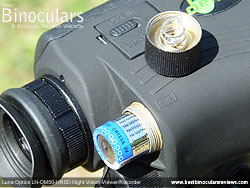 Battery Compartments
Battery Compartments
There are a couple of spring mounted screw on caps that each give you access to a chamber that accepts one 3v Lithium Cell type CR123A battery. Whilst this size may not be instantly recognizable to many, replacements are easy to come by, especially on the web at places like Ebay or Amazon.
The manual states that the device has an operating time of around 5 hours, but this will largely be down to the amount of recording you do and how much time you spend with the IR switched on. Whilst I did not measure the time, I would reckon that I spent at least 5 hours using the device during testing and the battery indicator had only just dropped to half when it was returned.
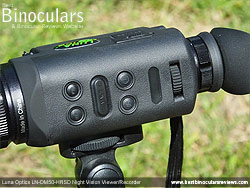 Top Surface
Top Surface
All of the main buttons and functions are located on the top (or on the side if mounted on a tripod) of the monocular. Unlike devices with buttons positioned on the side, this "neutral" location on the top is great as it does not favour either hand and so is equally easy to use no matter if you are left or right handed
I discovered that prior to going out in the dark, you do have to learn which button does what as they are almost impossible to see without a light, but once you do and by using my middle finger for the buttons nearest the main lens and my index finger for the ones nearest the eyepiece, I was able to completely operate the functions of the device using just one hand.
Where you do need to use your other hand and where these do differ to a camcorder is if you want to change the focus, because you have to turn the main objective lens, rather than just pressing a button.
Under the rubber covering the main shell looks to be made from a metal, which I think is aluminium. Whilst this may be a little heavier, it makes for a much robust and sturdier device that also feels better quality than some plastic bodied ones I have used in the past.
The partially exposed wheel located nearest the eyepiece in known as the "brightness wheel" which changes the exposure so that you can adjust the brightness of the image to suit the conditions and your personal preferences.
Then just in front of the wheel are two buttons, the one on the right is the main power on/off button and the other switches the IR on and off.
The rocker switch in front of these is the zoom in and out button, which changes the digital magnification and then in front of that are the camera and video buttons that you press to either take still pictures or video.
Front
The front section is where the objective lens and the IR illuminator is positioned. To the either side of the IR lens are a couple of output ports, one is the video output and the other is the DC output, which enables the device to be powered using mains electricity and not the onboard batteries for longer periods of use.
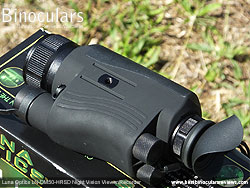 Sides
Sides
The one side (left if viewed from the rear) is where Luna Optics have placed the tripod mounting thread. If it was not for the fact that they also describe it as an "accessory mount", where you would probably mount products like an extended range IR Illuminator like the LN-PB3, I would be completely confused as to why this was not positioned on the underside as it is on most other devices.
The other side of the device has a spring loaded access panel that is lockable and gives you access to the SD and USB compartment:
Within this compartment is the slot which takes a standard Micro SD card and is where all your videos and still pictures are stored.
Under that is the USB output, to which you can connect the included cable and which allows you to connect the LN-DM50-HRSD to your computer or other device, to view and download the images and videos stored on the Micro SD card.
Weight
Weighing 400g (14oz), you can see from the comparisons below that this is relatively light even though it uses a robust, but heavier metal chassis:
Dimensions
Luna Optics state the dimensions as being 17cm (6.7") long, by 8cm (3.1") wide, by 6.3cm (2.5") high, which I can confirm are correct and which confirm that this is nice and compact unit that will easily fit into the palm of most peoples hands.
Waterproofing
Whilst not fully waterproof, this Luna Optics Night Vision monocular does have a water-resistant body, which so long as you are reasonably careful means that you should be able to use it in most poor weather conditions.
It is important to keep in mind that when you look through the eyepiece on the Luna Optics LN-DM50-HRSD night vision viewer, you are not actually looking through the device, but instead looking at a tiny screen inside the eyepiece. So when setting up the monocular, you first need to focus the eyepiece lens onto the screen for your particular eyesight.
This is simply achieved by turning the ring located just in front of the main eyepiece housing until you get as sharp an image as you can. This adjustment only needs to be changed if you share the monocular with others and they have different vision to yours.
Once the eyepiece is correctly focussed onto the screen for your eyesight, all you need to do to focus the LN-DM5 on objects at different distances away is to turn the objective lens barrel at the end of the unit.
This is simple enough, but has some resistance to prevent unwanted turning and because it is large with a grooved rubber coating, I found it was easy to do even with my thick winter gloves on.
To adjust the focus from the extremes of near to far takes exactly one complete turn of the barrel (360°). Whilst this does make it quite a bit quicker to change from near to far than on some that I have tested because they require more turns, it in theory also means that it is harder to fine tune the focus, but I never really had a problem getting the image pin sharp.
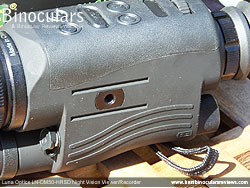 Mounting on a Tripod
Mounting on a TripodAn important feature of the LN-DM50 is that it can be easily mounted onto a tripod. I say important because if you want to get the the best quality of image without any blurring or a nice and steady video, you really need to mount it onto a fixed base.
Unlike most that position the thread used for mounting on the underside of the unit, on this monocular it is actually located on the side. This would not really make much of a difference except for the fact that unless you have a tripod head that can flip 90°, all your photos and videos will now be shot in portrait mode.
Other than to state that they use "all-glass optics" in the LN-DM50, Luna Optics do not go into any detail as to the makeup of the optical system and so I cannot comment.
They do mention that the optics are Multicoated, which indicates that some glass surfaces (usually the outer ones on the ocular and objective lenses) have received multiple coatings of an anti-reflection material. This helps improve the amount of light transmitted through the lenses as less is reflected away or in an unwanted direction, which improved the brightness and quality of image an optical instrument can produce.
Fully Multi-coated optics, where every glass surface is coated are definitely considered better on a pair of binoculars as it improves the transmission levels even further, which I assume would also be the same here on this NV device, but is definitely an improvement on devices that are single coated or not coated at all.
40mm Objective Lens
The lens itself is 40mm in diameter, which has the advantage of being lighter and helps to ensure a more compact device than those with larger lenses, but will not be able to collect as much light and thus potentially not be able to produce as bright an image. Indeed this is the main reason why binoculars designed for astronomy tend to have objective lenses that are so big.
I also measured the distance from the end of the barrel to where the objective lens is fixed to be 10mm, this offers a good amount of protection to the glass and it's coatings from dust, rain and will help prevent unwanted reflections that could either give you away or adversely affect the image.
The ocular lens is 15mm in diameter.
Magnification
Night vision is quite different to daytime optics like binoculars where the far greater amount of available light means the loss of some of it through the thicker glass and lenses needed to increase the magnifications is not as critical.
So the 5x optical magnification on the Luna Optics LN-DM50-HRSD is in itself is quite powerful for night vision, but if you add to this the variable digital magnification that goes right up to 20x this is by far the highest powered NV device I have ever tested.
Luna Optics state that their "state-of-the-art electronic zoom system" enables the devise to magnify the image up to 20x "any noticeable pixilation!" to the image. To a point I would agree with this and through the viewfinder it is only in very dark conditions that you start to see a deterioration of the image. However at the higher powers it is very hard and almost impossible to keep the device still enough to be able to take reasonable quality photographs or video without any blurring or camera shake. So if you think you will be doing this on a regular basis you will most certainly be needing a tripod.
Field Of View
At 6° (with the magnification at 5x) the field of view (FOV) is somewhat less than many devices I have used, but this is often the trade-off to having a more powerful magnification. Although devices like the Luna Optics LN-DM5 that has 9° FOV and also a 5x magnification.
A wide FOV is almost always a desired feature, but in some ways even more so at night, because the more you can see at once, the more easy it is to find and indeed track what ever it is you are searching for.
Note: As you increase the magnification and "zoom" in on an object, the FOV obviously also decreases until at 20x it is down to 4°.
Minimum Focal Distance
The closest you can focus on an object is a very near 50cm (1.6ft) away and whilst this distance may be irrelevant to many, I guess there may be some people out there who are studying insects, frogs etc at night and this will be an important aspect.
Max Effective Viewing Distance:
As with some other Luna Optics devices I have used, these are rated as having a maximum viewing distance at night of of 250m (273yds), which is really good. As you can see from the example videos and photos below, you can definitely see clearly up to 100 meters, and then if there is a reasonable amount of ambient light, distant objects up to and over 250 meters are visible through this device.
Built-in IR illuminator
This NV viewer comes with a built-in IR (Infrared) illuminator that when turned on acts like a torch to the device, but which is invisible to our eyes and so enables the viewer and recorder to work in complete darkness or improve the view when needed.
Described by Luna Optics as being "super powerful 500mW IR illuminator" that has a "viewing distance up to 200m in total darkness", I found that it was really effective at closer distances (under 50m) then it slowly dropped off until at around 100meters the effectiveness was fairly small. I suppose in very dark conditions it would work at around 200meters, but the effect would be quite minimal.
 |
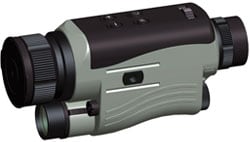 |
 |
 |
|
| Luna Optics LN-DM50-HRSD | Luna Optics LN-DM50 | Luna Optics LN-DM5 | Night Owl iGen Digital NV | |
| Price (approx): | $450 / £500 | $180 / £150 | $180 / £150 | $430 / £700 |
| Device Type: | Digital NV Monocular | Digital NV Monocular | NV Monocular | Digital NV Monocular |
| Record Images & Video | Yes | No | No | Yes |
| LCD | 0.24" TFT 320x240 | 0.24" TFT 320x240 | ||
| Max Light Amplification | 300 - 10000x | |||
| Sensitivity (microamperes per lumen) | 400-900 | |||
| Sensitivity (lux) | 0.03 | 0.03 | 0.003 | |
| Max Image Resolution: | Equivalent to 70lp/mm | Equivalent to 70lp/mm | 30 lp/mm | |
| Magnification: | 5-20x | 5x | 5x | 2.6x |
| Objective Lens: | 40mm | 50mm | 50mm | 39mm |
| Weight: | 14oz (397g) | 14oz (400g) | 17oz (480g) | 21 oz (595g) |
| Length: | 6.7in (17cm) | 6.7in (17cm) | 7.1in (18cm) | 8.8in (22.4cm) |
| Width: | 3.1in (7.9cm) | 3.1in (8.0cm) | 3.3in (8.3cm) | 3.9in (9.9cm) |
| Height | 2.5in (6.4cm) | 2.5in (6.3cm) | 2.2in (5.8cm) | 2.6in (6.6cm) |
| Field of View (degrees) | 6° - 4° | 6° | 9° | 12° |
| Max Viewing Distance: | 250m (820ft) | 250m (820ft) | 250m (820ft) | ? |
| Close Focusing Distance: | 1.6ft | 1.6ft | approx 1ft | 16ft |
| Tripod Adaptable | Yes | Yes | Yes | Yes |
Luna Optics advertise the LN-DM50-HRSD as being able to capture still images in JPEG format with dimensions of 1024x768 and a resolution of 1.3MP. Compared to a traditional still camera this is will seem very low and indeed it is, but remember this "camera" is capable of taking these images in almost complete darkness and is designed more to take evidence and surveillance type photos.
Daytime Photo Examples
I took the example photos below during the day when the light was good with the Luna Optics LN-DM50-HRSD. The only editing I have done is to add my logo to the image (Click on each image to view the full sized version). As you can immediately see the image quality does not match that of your traditional camera, so don't get this device to replace that, but should you want to capture what you are viewing as some sort of proof or evidence, then this will do quite fine.
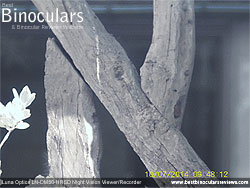 |
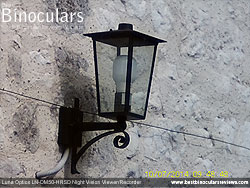 |
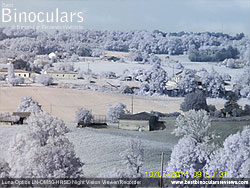 |
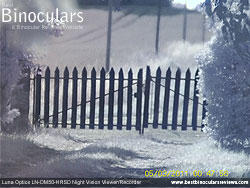 |
Evening Photo Examples
The photos below were taken in the evening just after the sun had set, so whilst you would never call it light, there was still a reasonable amount of ambient light about:
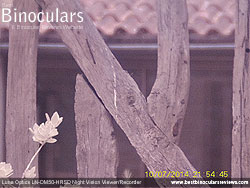 |
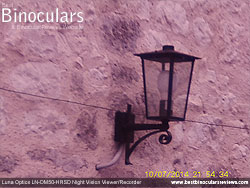 |
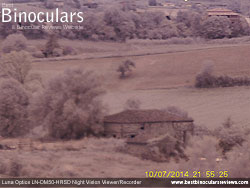 |
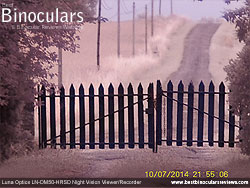 |
Night Photo Examples
The examples below were taken with the Luna Optics LN-DM50-HRSD at night. It was completely overcast night (so no moon or stars) and where I currently live is out on a farm, so far away from any neighbors or street lights and there were no lights on from my house - it was dark!
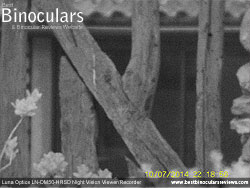 |
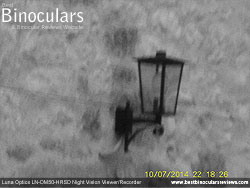 |
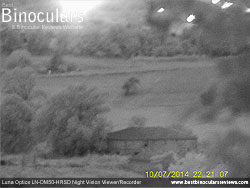 |
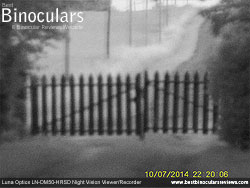 |
Night - with the IR On
As you know the Luna Optics LN-DM50-HRSD night vision monocular comes with an integrated IR (Infrared illuminator), which as you can see from the photos below taken with it on, it basically works like a torch for the device, although to our eyes it is invisible. As with a normal torch, it is only really effective over shorter distances - from my experience less than about 100 meters.
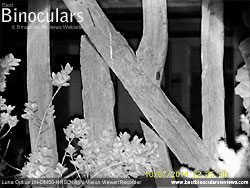 |
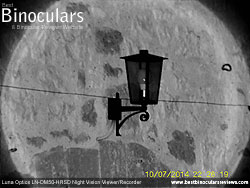 |
The video below demonstrates the quality of image produced at different light levels and at different distances. There is a section that shows me zooming in, changing the magnification from 5x to 20x and back out again and towards the end of the video, I also demonstrate the effectiveness of the IR at varying distances. Note: All the footage on this video was taken hand held and without the use of a tripod, which I think gives you a good idea as to how stable you can keep the image.
The quality of the image that you see whilst looking through the LCD viewfinder is very similar, indeed almost identical in quality to that of the video and photos that it takes, so I think you can get a very good idea of what you can see both during the day and at night by looking at the images and videos above.
Carry Case
The monoculars fit nice and snugly within the case, however it is only very lightly padded and so does not provide quite as much impact protection as on some. It has a separate pouch on the front that is designed to carry the cables, adapter and included cleaning cloth and on the rear is a belt loop.
Also included is a simple, un-padded carry strap that fixes to the case via a couple of quick release clips that really make it simple to take on and off depending on your preferences.
Access to the main compartment and the pouch is via full length zips which are really secure and make sure that none of the smaller pieces accidentally fall out.
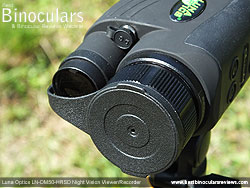 Lens Cover
Lens Cover
Made from what feels like a soft plastic, the lens cover attaches securely to the end of the barrel, but not too much so as to make taking it on and off a problem.
I love the fact that it is tethered to the body of the monocular (it actually has loop that goes around the IR barrel), because this is one part that is really easy to misplace, especially when you are out in the field in complete darkness.
Whilst you can use this device in the day, the cover has a tiny pin hole like standard NV has that I suppose in this case enables you to replicate night time conditions by restricting the amount of light made available to the lens.
Lens Cleaning Cloth
As with all the other Luna Optics devices I have used, they have supplied a cleaning cloth and whilst it may not be the best quality micro fiber cloth, at least one is included which is actually not that common when purchasing NV gear.
I would however like to add that I would still recommend that you get yourself a higher quality lens cleaning kit, that will ensure you care for and clean the lenses properly.
Manual & Warranty Information
As you would expect, Luna Optics also include a manual that explains how this and indeed generally how how digital night vision works and goes over subjects the main parts, buttons, installing batteries and specifications. Whilst it does cover all the important parts, the manual is a little too short in my opinion.
Also within the manual, you will find a couple of other pieces of paper that explain the one year warranty and the registration information.
Strong Points: I think one of the strongest aspects of the Luna Optics LN-DM50-HRSD is the versatility of it. Having a device that you can not only use to view what is going on at night, but record what you are seeing is great.
The overall build quality looks excellent to me and the device really have a nice solid feel to it that is somewhat satisfying.
Their performance in the dark is excellent and easily up there with the best NV devices that I have used, which if you take into account that you can now also take an image or a video of what you are seeing is great.
The IR is powerful and works really well, especially at short, to mid range distances and whilst it may outperform most at longer distances, it still is not quite as powerful as a specially designed extended range IR Illuminator. However if you do require a longer range, you could always get one like the excellent LN-PB3 that will fit to the accessory/tripod mount on the side of this device.
The 5x magnification is great and as I mentioned quite powerful in the night vision world, but if you include the digital zoom, it is really impressive and means you can quickly find and lock onto what you want to see at 5x power and then zoom in to potentially get a better view.
Weaknesses: For those who are expecting to capture very high quality photos, this device may come as a slight disappointment as there is no denying that especially the photo quality does not compare with your standard camera even during the day. However as nice as that would be, I do not think that is the aim here as the image capture on the LN-DM50-HRSD is more about capturing proof or evidence or just to show off to your friends what incredible creatures you managed to see whilst waiting up at night next to that watering hole whilst on safari!
Ideal Uses: As with other similar compact night vision devices, this Luna Optics LN-DM50-HRSD is ideal for taking camping, observing most nocturnal wildlife, especially on trips like safari holidays, on hunting trips, as well as your night time personal security needs. The ability to record what you see also adds another dimension to this, be that for evidence or just for going back to see what was out there.
Reviewed by Jason Whitehead for Best Binocular Reviews
|
 Awards:
Awards:Main Specifications & Features:

Below are similar pairs of Night Vision Monoculars that you may also want to have a look at:
High performance digital night vision monocular that can take pictures and record video, comes with built in IR emitter
General Price Range: (4/6) Mid-High Value Night Vision Monoculars
Below is a link that will take you to a page with online retailers in both the US and UK that sell Luna Optics 5-20x40 LN-DM50-HRSD Night Vision Monoculars this page makes it easy to compare prices and then to buy from your preferred option:
|
Buy & Compare Prices for the Luna Optics 5-20x40 LN-DM50-HRSD Night Vision Monoculars |
||
US Shoppers |
Canadian Shoppers |
UK Shoppers |
Deutsch Shoppers |
Aussie Shoppers |
Indian Shoppers |
